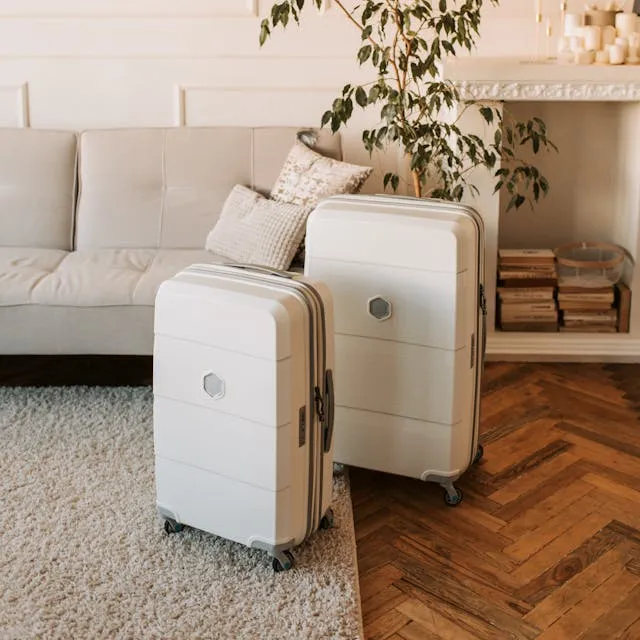As a leading luggage manufacturer and supplier in China, we understand that choosing the right luggage material is crucial for both quality and performance. Whether you’re looking to source luggage for your business or need a reliable suitcase for personal use, selecting the right material will directly affect durability, weight, appearance, and price.
In this article, we’ll compare the two most popular materials used in luggage manufacturing: Polycarbonate (PC) and Aluminum-Magnesium Alloy. Let’s dive into the details to help you make an informed decision.
1. Durability of Polycarbonate vs. Aluminum-Magnesium Alloy Luggage
1.1 Polycarbonate (PC) Luggage
Polycarbonate (PC) is a high-strength plastic known for its excellent toughness and impact resistance. PC luggage can withstand substantial external forces without cracking or breaking, even when subjected to pressure or impact. It also has elasticity, allowing it to return to its original shape after deformation, which makes it ideal for frequent travelers.
1.2 Aluminum-Magnesium Alloy Luggage
Aluminum-Magnesium Alloy is a high-strength material with superior hardness. Aluminum-magnesium alloy luggage excels in pressure and impact resistance, offering excellent protection for your belongings. However, in extreme conditions, it may become prone to dents or deformation due to its brittleness.
Summary: Polycarbonate luggage excels in impact resistance, while aluminum-magnesium alloy luggage offers superior compression resistance. Both are durable but cater to different needs.
2. Weight Comparison: Polycarbonate vs. Aluminum-Magnesium Alloy
2.1 Polycarbonate (PC) Luggage Weight
PC luggage is lightweight, which is a huge advantage for travelers. As a China-based luggage supplier, we prioritize lightweight materials to ensure our clients can offer luggage that’s both durable and easy to carry. Polycarbonate is especially suitable for long-haul travel, where ease of handling matters most.
2.2 Aluminum-Magnesium Alloy Luggage Weight
While aluminum-magnesium alloy luggage is heavier, it offers a premium feel and extra durability. If you’re sourcing high-end luggage, this material could be perfect, though the added weight might be a disadvantage for those prioritizing lightness.
Summary: Polycarbonate luggage is lighter, making it easier to carry, while aluminum-magnesium alloy luggage provides superior durability but at the cost of extra weight.
3. Appearance and Texture: Polycarbonate vs. Aluminum-Magnesium Alloy
3.1 Polycarbonate (PC) Luggage Aesthetics
Polycarbonate luggage is sleek, modern, and available in a variety of colors and designs. At our Chinese luggage manufacturing facility, we offer polycarbonate luggage with various textures and finishes to meet the style preferences of international buyers. This material allows for flexibility in design, making it perfect for fashion-conscious travelers.
3.2 Aluminum-Magnesium Alloy Luggage Aesthetics
Aluminum-Magnesium Alloy luggage is known for its luxurious, metallic finish. This material is often used for high-end, business-class luggage. It exudes sophistication and durability, making it ideal for customers who seek elegance and strength in their travel gear.
Summary: Polycarbonate offers more design versatility, while aluminum-magnesium alloy offers a classic, high-end aesthetic suitable for premium buyers.
4. Price Comparison: Polycarbonate vs. Aluminum-Magnesium Alloy Luggage
4.1 Polycarbonate (PC) Luggage Price
Polycarbonate luggage is cost-effective, making it ideal for bulk purchasing at competitive prices. As a Chinese B2B luggage supplier, we provide affordable, durable PC luggage for international wholesalers, retailers, and businesses. This material offers excellent value without compromising on quality.
4.2 Aluminum-Magnesium Alloy Luggage Price
Due to the manufacturing complexity and premium materials, aluminum-magnesium alloy luggage is typically more expensive. For buyers looking for top-tier quality and willing to invest in luxury luggage, this material is an ideal choice.
Summary: Polycarbonate luggage is more budget-friendly, whereas aluminum-magnesium alloy luggage caters to high-end markets.
5. Maintenance and Care: Polycarbonate vs. Aluminum-Magnesium Alloy Luggage
5.1 Polycarbonate (PC) Luggage Maintenance
PC luggage is easy to maintain, requiring only occasional cleaning to maintain its pristine look. Its high impact resistance makes it more resilient, thus reducing the need for constant maintenance.
5.2 Aluminum-Magnesium Alloy Luggage Maintenance
Aluminum-Magnesium Alloy luggage requires regular care to prevent metal oxidation and scratches. In humid climates, extra attention is needed to avoid rust, which may be a concern for some buyers.
Summary: PC luggage is lower maintenance, while aluminum-magnesium alloy luggage requires more care to maintain its metallic finish.
Conclusion: Which Luggage Material Should You Choose?
As a reliable luggage supplier based in China, we offer a wide range of options for businesses looking to source high-quality luggage for global distribution. Whether you choose polycarbonate (PC) or aluminum-magnesium alloy, both materials have distinct advantages:
- Polycarbonate Luggage: Ideal for businesses seeking lightweight, durable, and cost-effective luggage. PC offers great impact resistance and is suitable for businesses looking to appeal to a wide market.
- Aluminum-Magnesium Alloy Luggage: Perfect for businesses that want to provide premium luggage to high-end consumers. It offers superior protection, luxury, and durability but comes at a higher price point.
Both materials cater to different segments of the market. Understanding the strengths of each material helps you make an informed decision when sourcing luggage for your business.


